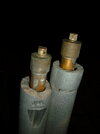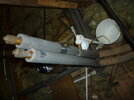I have a twist & lock 22mm Speedfit-type connector (though I think it's a generic brand) on the central heating system and it has sprung a small leak so wish to replace it with similar. I would grateful for comments on my plans to carry out the replacement.
The gas central heating system is based on a system boiler and is a sealed system with two expansion vessels (because the original expansion vessel built into the boiler casing didn't have enough capacity). Fortunately, the leaking connector is in the loft and almost at the highest point in the system. In fact, the leaking connector is on one of two 500 - 600 mm vertical pipe sections that have a valve at the top end and appear to be for venting air - at least that's what I used them for when venting air from the gravity CH system it once was. See photo. One of these vent pipes is on the radiators' supply "ring main" and the other on the radiators' return main.
I have little experience of pressurised CH systems/expansion vessels so I'd like to check that my repair plans are not likely to cause damage or other problems. This is what I plan to do:
1 Turn off the boiler (incl. integral circulating pump) at the mains switch.
2 Drain some water from a convenient radiator drain point until the system pressure is ??? 1 or 2 litres maybe?
3 In the loft, open the air vent in the vertical pipe to allow the water level in the pipe to reduce ??? How do I judge this?
4 Remove leaking connector. Check condition of pipes (one plastic, one copper) and clean/debur as required. Replace connector with similar new one. Can't see any branding marks on the 22mm plastic pipes or the connectors. Will any generic 22mm twist & lock connector be OK?
5 Close loft air vents and re-pressurize system to normal pressure (about 1 bar cold) using filling loop.
6 In loft, vent air from system. Repeat steps 5 and 6 as necessary.
Is this a suitable method? Appreciate any guidance. Many thanks.
The gas central heating system is based on a system boiler and is a sealed system with two expansion vessels (because the original expansion vessel built into the boiler casing didn't have enough capacity). Fortunately, the leaking connector is in the loft and almost at the highest point in the system. In fact, the leaking connector is on one of two 500 - 600 mm vertical pipe sections that have a valve at the top end and appear to be for venting air - at least that's what I used them for when venting air from the gravity CH system it once was. See photo. One of these vent pipes is on the radiators' supply "ring main" and the other on the radiators' return main.
I have little experience of pressurised CH systems/expansion vessels so I'd like to check that my repair plans are not likely to cause damage or other problems. This is what I plan to do:
1 Turn off the boiler (incl. integral circulating pump) at the mains switch.
2 Drain some water from a convenient radiator drain point until the system pressure is ??? 1 or 2 litres maybe?
3 In the loft, open the air vent in the vertical pipe to allow the water level in the pipe to reduce ??? How do I judge this?
4 Remove leaking connector. Check condition of pipes (one plastic, one copper) and clean/debur as required. Replace connector with similar new one. Can't see any branding marks on the 22mm plastic pipes or the connectors. Will any generic 22mm twist & lock connector be OK?
5 Close loft air vents and re-pressurize system to normal pressure (about 1 bar cold) using filling loop.
6 In loft, vent air from system. Repeat steps 5 and 6 as necessary.
Is this a suitable method? Appreciate any guidance. Many thanks.



